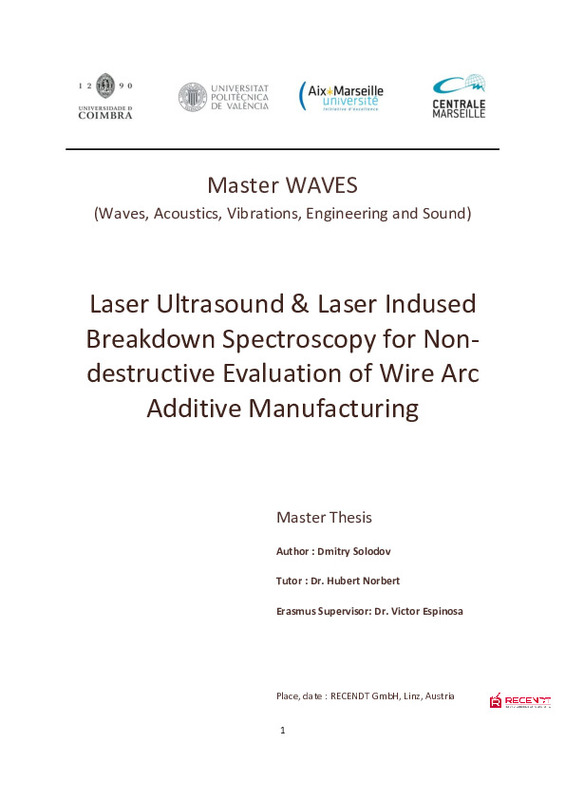|
Resumen:
|
[EN] Additive manufacturing (AM) is an advanced fabrication process based on the sequential layering of
materials, which is driving a transformative shift in modern manufacturing by creation of the
components with enhanced ...[+]
[EN] Additive manufacturing (AM) is an advanced fabrication process based on the sequential layering of
materials, which is driving a transformative shift in modern manufacturing by creation of the
components with enhanced geometrical complexity, reduced material waste, and improved
structural integrity. AM of metal components, specifically using Wire Arc Additive Manufacturing
(WAAM), involves heating of the metal to its melting point, leading to alterations in the material's
chemical structure and creation of structural defects. Consequently, Non-Destructive Testing (NDT)
for these materials requires both chemical analysis and physical evaluation through new nontraditional NDT techniques. This master's thesis investigates the suitability and precision of Laser Induced Breakdown Spectroscopy (LIBS) for monitoring chemical defects in the produced material,
while Laser Ultrasound (LUS) is employed to examine structural defects. The research aims at
exploring the applicability and accuracy of LIBS and LUS as complementary approaches in the NDE of
metallic samples. This thesis comprises four chapters, each addressing different aspects of the
experimental methodology for NDE of metal components produced by the WAAM technique.
The first chapter presents some traditional NDE methods for detecting mechanical defects in
metal components. In the second chapter, a more detailed description of LUS and LIBS techniques is
provided, outlining their key elements and principles of operation. Chapter 3 offers an assessment of
the current state of LUS and LIBS methods and showcases their application and effectiveness in
evaluating AM metal structures. The experimental setup used for conducting the research and the
main results obtained from the application of LUS and LIBS are further discussed in Chapter 4. Both
B- and C-LUS scans are used to examine the transition from the substrate to the welded specimen,
critically determining the quality of fusion between them and detecting mechanical defects.
Furthermore, LIBS is employed to study model samples with varying silicon (Si) and magnesium (Mg)
content, accurately determining changes in chemical composition, whether gradual or abrupt. A
developed Python code facilitates visualization and processing of the acquired LIBS data. For a
comprehensive NDE approach, a special aluminum sample is used to combine LIBS and LUS
techniques in detecting both chemical inclusions and structural defects. LIBS is proved to be effective
in identifying chemical inclusions (Mg), while LUS not only detects mechanical defects but also
reveals the presence of chemical inclusions due to the density disparity and some velocity between
magnesium and aluminum. The synergistic utilization of both methods demonstrates their
complementarity, enabling a comprehensive NDT of the WAAM components.
[-]
[ES] La fabricación aditiva (AM) es un proceso de fabricación avanzado basado en la estratificación secuencial de materiales, que está impulsando un cambio transformador en la fabricación moderna mediante la creación de ...[+]
[ES] La fabricación aditiva (AM) es un proceso de fabricación avanzado basado en la estratificación secuencial de materiales, que está impulsando un cambio transformador en la fabricación moderna mediante la creación de componentes con mayor complejidad geométrica, menor desperdicio de material y mayor integridad estructural. La AM de componentes metálicos, concretamente mediante la fabricación aditiva por arco de alambre (WAAM), implica el calentamiento del metal hasta su punto de fusión, lo que provoca alteraciones en la estructura química del material y la creación de defectos estructurales. En consecuencia, los Ensayos No Destructivos (END) para estos materiales requieren tanto el análisis químico como la evaluación física a través de nuevas técnicas END no tradicionales. Esta tesis de máster investiga la idoneidad y precisión de la Espectroscopia de Descomposición Inducida por Láser (LIBS) para monitorizar defectos químicos en el material producido, mientras que el Ultrasonido Láser (LUS) se emplea para examinar defectos estructurales. El objetivo de la investigación es explorar la aplicabilidad y precisión de LIBS y LUS como enfoques complementarios en la NDE de muestras metálicas. Esta tesis consta de cuatro capítulos, cada uno de los cuales aborda diferentes aspectos de la metodología experimental para la NDE de componentes metálicos producidos mediante la técnica WAAM.
[-]
|
|
Titulación:
|
Máster Universitario Erasmus Mundus en Ondas, Acústica, Vibraciones, Ingeniería y Sonido / Erasmus Mundus Master in Waves, Acoustics, Vibrations, Engineering and Sound (WAVES)-Màster Universitari Erasmus Mundus en Ondas, Acústica, Vibracions, Enginyeria i So / Erasmus Mundus Master in Waves, Acoustics, Vibrations, Engineering and Sound (WAVES)
|







